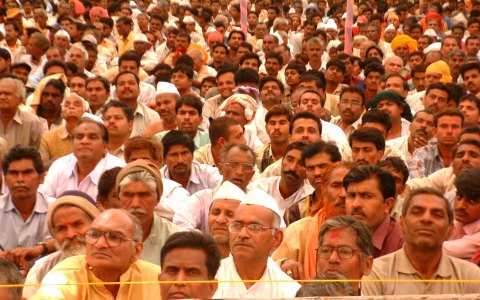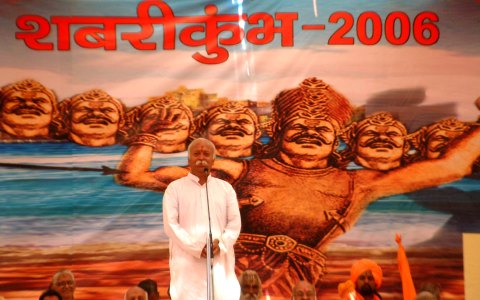Responses to gang-rape expose India’s spiritual bankruptcy
by - 9th January 2013
 For India’s masses, the inhuman gang-rape of a 23-year-old woman in Delhi was apparently a call for better enforcement of law and order. At least religious leaders were expected to help focus the nation’s attention to correcting attitudes, but few spoke up, and those who did ended up perpetuating the very mentality behind the bestiality.
For India’s masses, the inhuman gang-rape of a 23-year-old woman in Delhi was apparently a call for better enforcement of law and order. At least religious leaders were expected to help focus the nation’s attention to correcting attitudes, but few spoke up, and those who did ended up perpetuating the very mentality behind the bestiality.
Even a cursory look at statistics will reveal how women are treated in Delhi, or elsewhere in India. More than 600 rapes were reported to police in Delhi between January and November 2012, according to Press Trust of India. But Indians are immune to stories on rape in newspapers.
What caused popular uproar after the Dec 16 incident was the barbarity with which the victim, a paramedical student, was raped and assaulted.
She died on Dec 29 from multi-organ failure due to injuries from an assault that involved penetration with a blunt object, possibly a rusted wheel jack. Police records say a juvenile suspect – one of the six accused – extracted her intestine with his bare hands after raping her twice in a moving bus.
Until these details emerged, a usual public apathy prevailed. “We were without clothes [after being thrown off the bus]. We tried to stop passers-by. Several auto rickshaws, cars and bikes slowed down but none stopped for about 25 minutes,” the victim’s male companion, who was also hit with an iron rod, told Zee News. Police also arrived late, and wasted more time in discussing jurisdiction, he added.
Later, masses took to the streets, calling the woman passers-by had merely looked on, ‘India’s Daughter.’ Their demands – capital punishment for rape convicts including juveniles and stricter sex crime laws– were directed primarily towards authorities. The underlying issue concerning attitudes towards women was discussed only at dinner tables.
Some personalities associated with religion did suggest there was more to the high incidence of rape than law and order. But the content of their messages was as shameful as the incident itself.
 Most notable among them was Mohan Bhagwat, the chief of India’s largest Rightwing Hindu group, Rashtriya Swayamsevak Sangh. Blaming rapes on Western culture, he advised women to restrict themselves to household chores and ‘satisfy’ their husbands.
Most notable among them was Mohan Bhagwat, the chief of India’s largest Rightwing Hindu group, Rashtriya Swayamsevak Sangh. Blaming rapes on Western culture, he advised women to restrict themselves to household chores and ‘satisfy’ their husbands.
Ashok Singhal, a top leader of the Vishwa Hindu Parishad, or World Hindu Council, which is known for launching violent attacks on religious minorities, said Indians’ adoption of U.S. culture is responsible.
Asaram Bapu, a prominent Hindu godman, said the woman ‘is as guilty as her rapists... Can one hand clap? I don’t think so.’ Later, he responded to calls for stricter laws, saying that ‘women with loose morals’ must not be allowed to target men.
At the heart of these responses were patriarchal notions propagated by Manusmriti, an ancient Brahminical Hindu text. While Brahmins – the highest caste as per hierarchy in Hindu societies – account for only about five percent of India’s population, they have dominated the nation’s politics, society and business.
‘In childhood a female must be subject to her father, in youth to her husband, when her lord is dead to her sons; a woman must never be independent,’ states Manusmriti in verse 148 of Chapter 5.‘Though destitute of virtue, or seeking pleasure (elsewhere), or devoid of good qualities, (yet) a husband must be constantly worshipped as a god by a faithful wife,’ says 5/154.‘ It is the nature of women to seduce men in this (world); for that reason the wise are never unguarded in (the company of) females,’ states 2/213.
The ‘religious’ responses to the gang-rape did call for ‘respect’ of women in society, but from the man’s vantage point, from where women are seen as property of their male masters and are expected to remain confined to their homes. For a man, if a woman chooses not to abide by the role assigned to her, she is responsible for her own safety.
Implicit in these messages was the admission that many Indian men do not still know how to respond to a woman who is out of her home alone, but to sexually abuse her. True to the spirit of Manusmriti, these religious figures will saythe blame lies in the woman while the man’s lecherous nature is a given.
Rape is not unique to one country. Man is man whether he is in Hindu-majority India or largely Christian Britain. But in the absence of religious resources from which values of equal dignity can be drawn, people have little option but to call for draconian laws to maintain ‘law and order’, which is a trait of an atheist State.
- Log in to post comments
